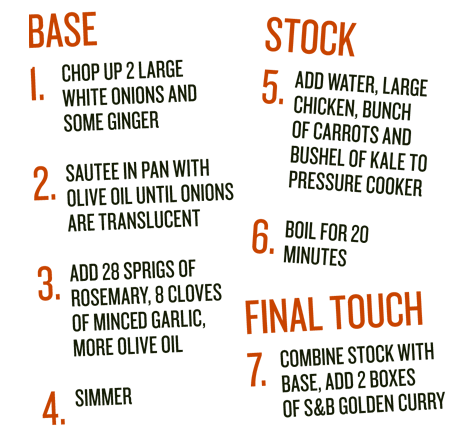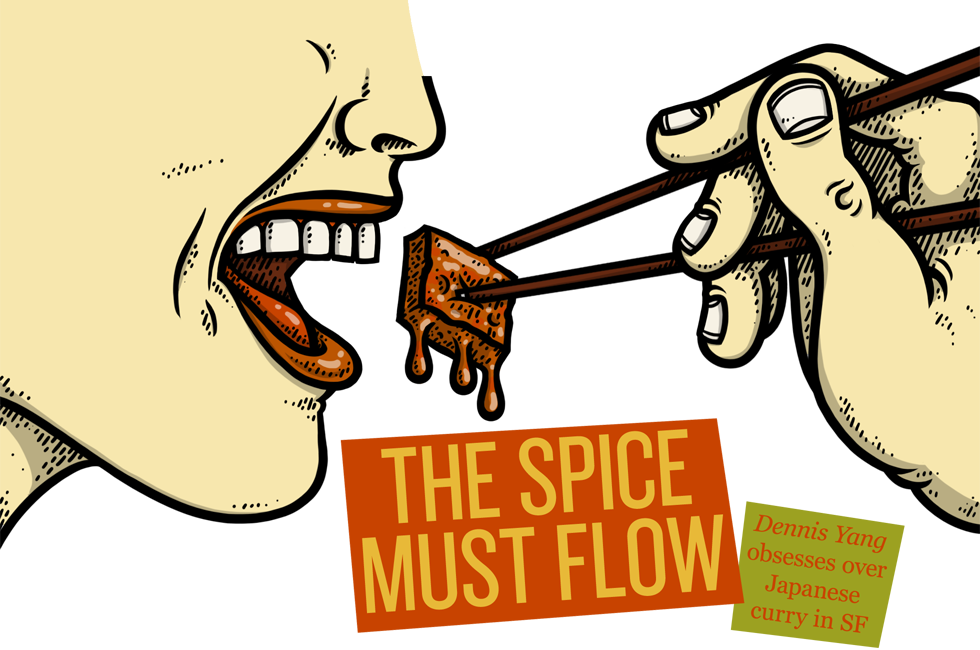
By Dennis Yang
I was first introduced to Japanese curry by Dan, my loud Jewish friend from Ohio. Years ago, while in Japan as a foreign exchange student, he developed a taste for Japanese curry — specifically, katsu curry, which is served up with a panko-crusted fried cutlet, traditionally pork. Dan lived here in the early 2000s, and every week he and his entourage would descend upon Hotei in the Inner Sunset, the only San Francisco establishment whose offerings lived up to his childhood memories of his favorite dish.
There were a few very simple rules to Dan’s katsu curry dinner night:

Dan has since moved back to Ohio, but those of us who remain in San Francisco still carry on the katsu curry dinner tradition. I can proudly say that we pretty much adhere to the rules. Rarely have we deviated in our ordering, and the few women who have graced us with their presence are now my friends’ wives.
I wanted to learn the secret behind Hotei’s curry, so it was with the contained exuberance of a teenage fan seeing his favorite rock band that I meet with Eric Fujii, one of the proprietors of Hotei. Eric’s father, Steve, opened Ebisu (Hotei’s sister restaurant across the street) decades ago when he was only 18. In 2000, they opened Hotei, specializing in ramen and curry.

Hotei’s curry is an age-old family recipe created by Eric’s grandmother, Eric tells me as he tosses curry spices to a base of onions, beef, water, and stock. Then he adds a few special ingredients: coffee and apples. The bitterness of the coffee balances with the sweetness of the apples, which enhances the overall flavor. “The more layers of flavor,” he explains, “the better.” The whole mixture is then cooked for hours in a huge vat big enough to feed a small army, which seems fitting since this is a dish traditionally served in the Japanese military.
“Japanese curry is comfort food,” Eric says. I agree.
Eric has to head back to work, so I sit down at a table and order a plate of pork katsu curry. As I check into Hotei on Foursquare, I’m informed that I’ve just been crowned “mayor” of Hotei. Dan would be proud.
A few minutes later, my dinner arrives. The pork cutlet lies in slices atop a bed of white rice next to a healthy pile of red pickles called fukujinzuke . Chunks of beef, potatoes, and carrots swim in rich, brown gravy. As I shovel perfect scoops of rice, katsu curry, and pickles into my mouth, I can taste the many delicious layers of flavor that Eric had described.

I now wonder if I could make Japanese curry at home. I mean, it didn’t seem that hard. Admittedly, I’m not much of a cook. My New Year’s resolution was to make a meal for myself once a week. I lasted only a month, and that was using a very loose definition of “cooking” that many would call “heating in a microwave.”
Since I’m not intrepid enough to figure out curry making on my own, I contact Tomo Saito, known for throwing “kick-ass Japanese curry” parties” at Gravel & Gold, the eclectic Mission boutique where I purchased my beloved porcelain neti pot. At his last gathering, Tomo served over 150 bowls of his signature dish.
There wasn’t an event scheduled in the near future, but Tomo was kind enough to throw me a curry party at his lovely loft in the Outer Mission.

To start, Tomo makes the curry base by chopping up two large white onions and some ginger, which are then sautéed in a pan with olive oil until the onions are translucent. To that, we add 28 sprigs of rosemary, eight cloves of minced garlic, and more olive oil, and then let the fragrant mixture simmer on the stove.
Over two large bottles of Sapporo, we chat about Japan and peruse the numerous paintings that adorn his apartment — art accumulated throughout his years as a CCA student. Growing up in Tokyo, Tomo learned his curry recipe from his mother who made it once every two weeks when he was a kid. He explains that this is “house style” curry, and every time he makes it, it’s a little bit different, but that’s part of the appeal.

The base continues to simmer, so we start on the stock, which, Tomo explains, usually involves ground beef and a bottle of the infamous Two-Buck Chuck. But today we’re making chicken curry, so into a pressure cooker of boiling water goes a large chicken, a bunch of carrots, and a bushel of kale. With a twist of his wrist, Tomo clicks the pressure cooker shut, and the device emits an angry roar as it the liquid starts boiling up to temperature.
After about 20 minutes, Tomo opens the pot revealing a delicious chicken soup. To this he adds the simmering onion-ginger-rosemary-garlic mixture and then finally, two boxes of S&B Golden Curry, an instant roux that transforms the dish into a bubbling vat of homemade Japanese curry.
As if on cue, Tomo’s party guests — three fashionably dressed Japanese girls and Tomo’s coworker from his day job at a design firm — arrive right as the curry is finished. We ladle generous portions onto beds of rice and begin to happily consume the meal.
The homemade curry tastes quite different from Hotei’s, but has the same stick-to-your-ribs comfort factor that I was looking for. Hearty, tasty, and we made it ourselves.

Though I’m now armed with the knowledge of how to prepare Japanese curry, my quest to fully understand the dish wouldn’t be complete without a visit Muracci’s Japanese Curry & Grill, whose curry has adorned many a best-of list in San Francisco.
Muracci’s co-owner, Tamiko Murata, shows me how the curry is made. At face value, her process is remarkably similar to the Fujii’s: The broth is mixed with curry spices and vegetables and then cooked for a really long time. That said, the exact types and proportions of broth, spices, and vegetables are a closely guarded secret. All Tamiko shares is that it’s a mixture of onions, garlic, apples, tomatoes, and “other stuff.” Fair enough.
Hailing from Kobe, Japan, Tamiko opened her restaurant in the spring of 2008, naming it after her son. She designed the curry specifically for the hardworking San Franciscans in the Financial District. “There are a lot of vegetables in the sauce to make it healthy,” she proudly proclaims.
After spending time in Muracci’s kitchen, I’m ready to try the curry so I wander back at lunchtime and find an incredible number of hungry patrons crammed into the tiny Kearny Street space. The ambiance is best described as “Tokyo Subway Car at Rush Hour.” After waiting patiently in line, I finally get to the front and place an order for vegetable curry. I figure, as long as I’m cheating on Dan, I might as well go whole hog and deviate from the traditions altogether. I’m told that the wait will be 20 minutes; my stomach grumbles in protest. I slink away dejectedly after the girl behind me bouncily picks up the order she had smartly phoned in earlier. Mental note taken.

I seize this opportunity to run across the street to Ebisu’s newly opened FiDi location and grab a bowl of vegetable curry for an impromptu showdown. I then skip back into Muracci’s and pick up my order, furtively hiding the competitor’s product.
Since Muracci’s has only a handful of seats, most of the khaki crowd steals back to their corporate lunch dens. I hop on my bike and head over to Levi’s Plaza; it’s a gorgeous day for a curry picnic.
Muracci’s lunch comes in two parts: The curry is in a plastic tub and the rice and pickles are in a square box. Ebisu’s comes preassembled in a sealed round container, the same as those used by Mehfil, my favorite Indian curry place. That said, both approaches result in pretty much the same thing: a portion of piping hot Japanese curry over rice.
The curries look different. Ebisu’s is thick and chocolate-brown, whereas Muracci’s is reddish and thinner in consistency. As for taste, it’s hard to say which one is better because they’re remarkably different. Ebisu’s is hearty, whereas Muracci’s is a tad more delicate and spicy. It’s a cop-out to say this, but I’m not a food critic, so you should just go try them both and decide for yourself which is best.
Now that I know how to make it, I’m moving katsu curry dinner night to my house. Come on over. Just don’t tell Dan.

Try Japanese curry at Hotei in the Inner Sunset, or at Ebisu or Muracci’s in the Financial District. If you’re smart, phone your order in to Muracci’s ahead of time. I recommend pork katsu curry, with extra pickles. Keep an eye out on Gravel & Gold’s blog for Tomo’s next party. Or, pick up a box of S&B Golden Curry at your favorite Asian grocer and whip up some kick-ass Japanese curry of your own.
Design: Andy Warner







